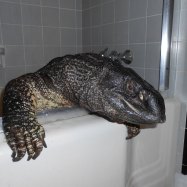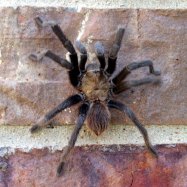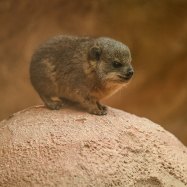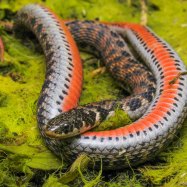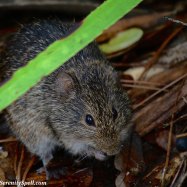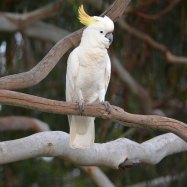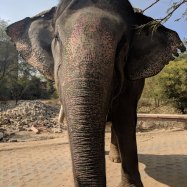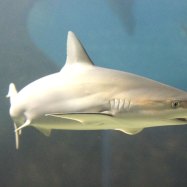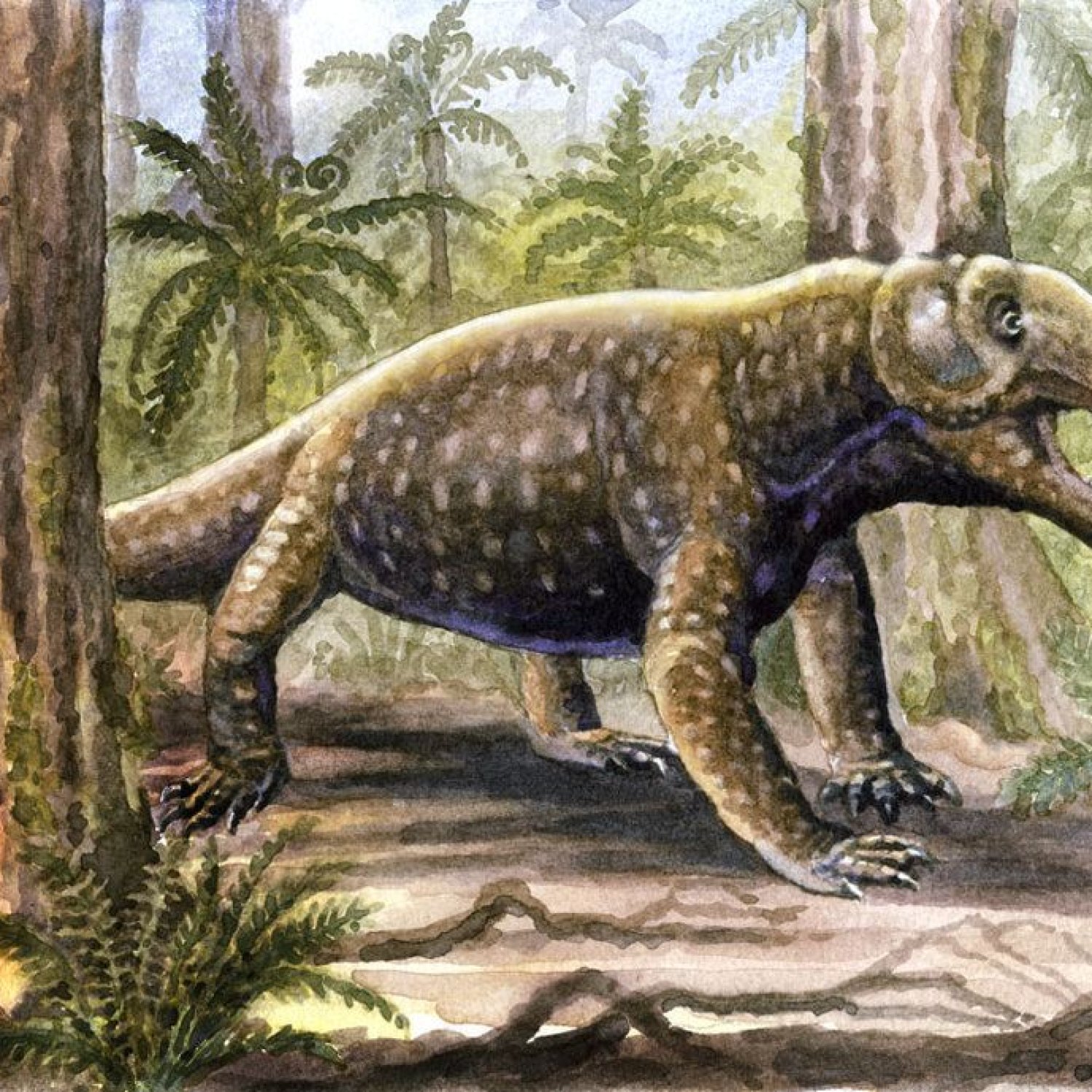
Anteosaurus
Approximately 5 meters
Discover the fascinating world of the Anteosaurus, a massive creature spanning 5 meters in length. Indigenous to the Karoo Basin, this member of the Anteosauridae family was known for its large and stocky body shape. Learn more about this ancient animal and its role in our planet's rich history. #Anteosaurus #KarooBasin #AncientAnimals
Animal Details Summary:
Common Name: Anteosaurus
Kingdom: Animalia
Habitat: Terrestrial
The Mighty Anteosaurus: The Carnivorous Creature of the Karoo Basin
Deep in the heart of South Africa, among the vast and dry landscape of the Karoo Basin, roamed a fearsome creature known as the Anteosaurus. This ancient animal, which belongs to the Synapsida class and the Anteosauridae family, was a dominant predator in its habitat during the Permian Period, approximately 265 to 250 million years ago. While it may have gone extinct millions of years ago, its legacy lives on through the study of its remains and the insights it provides into the world of this formidable creature.The Scientific Discovery of Anteosaurus
The discovery of Anteosaurus can be credited to South African paleontologist Robert Broom, who first unearthed this creature's fossils in the early 1920s Anteosaurus. Broom was well-known in the field of paleontology for his extensive work in South Africa, where he discovered several other ancient creatures, including other Therapsids, mammals, and hominids.Unlike many other ancient creatures, the discovery of Anteosaurus was not limited to a handful of isolated fossils. Instead, Broom's findings included almost complete skeletons, several skulls, and other significant skeletal elements, providing scientists with a wealth of knowledge about this creature's physical features and behavior.
The Physical Characteristics of Anteosaurus
One of the most striking features of Anteosaurus was its size. This creature was considered one of the largest and most robust of the Therapsids, with estimates putting its length at approximately 5 meters long. It had a large, stocky body, with a barrel-shaped chest and a short tail, proving that this animal was built for power and strength. Its legs were short and sturdy, ending in large, thick claws that aided in its predatory pursuits.Despite its large size, Anteosaurus was most likely not a fast runner due to its body shape and muscular build. However, it made up for this with its powerful jaw and sharp teeth, allowing it to take down prey with ease African Bush Elephant. Its jaw could open wide, creating a terrifying image of this creature's sharp, interlocking teeth, specially adapted for tearing through flesh and crushing bones.
The Habitat and Geographical Distribution of Anteosaurus
As mentioned, Anteosaurus roamed the vast and dry landscape of the Karoo Basin, which covers a large portion of the central and southern parts of South Africa. This region was characterized by its hot and arid climate, with moderate vegetation and occasional water sources, making it a suitable habitat for Anteosaurus and other carnivorous creatures.Apart from its presence in South Africa, there is evidence that Anteosaurus may have also existed in other parts of the world, such as Russia and Brazil. However, it remains uncertain whether these were actual Anteosaurus specimens or only closely related species.
Feeding and Hunting Behavior
As a carnivorous creature, Anteosaurus survived by preying on other animals. Its powerful jaw and sharp teeth were essential tools in its hunting and feeding behavior. These features were perfect for taking down prey of various sizes, including other Therapsids and even large, herbivorous dinosaurs.Scientists believe that Anteosaurus most likely hunted in packs, using its strong legs and claws to hold down its prey while its powerful jaws delivered a fatal bite. Its size and strength would have made it a dominant predator, instilling fear in the creatures that shared its habitat.
The Extinction of Anteosaurus
While Anteosaurus was once a dominant predator in its habitat, it, along with many other ancient creatures, eventually went extinct. The exact reason for its extinction is still unknown, but several theories suggest that it could have been due to a combination of environmental changes, competition for food with other carnivorous creatures, and possibly even disease.Some scientists also suggest that its extinction could have been a result of a catastrophic event, such as a massive volcanic eruption or an asteroid impact. Whatever the cause, the extinction of Anteosaurus marked the end of an era and the beginning of a new one, as other creatures began to evolve and adapt to the changing environment.
The Legacy of Anteosaurus
Despite its extinction, Anteosaurus continues to have a lasting legacy in the world of paleontology. Through the study of its remains and fossilized footprints found in the Karoo Basin, scientists have been able to gain valuable insights into the physical characteristics and behavior of this ancient creature. It has also shed light on the ecological and environmental dynamics of the Permian Period and the effects of extinction on the world's biodiversity.In recent years, there has been a renewed focus on the study of Anteosaurus and other Therapsids, with new discoveries and research shedding more light on these fascinating creatures. By understanding the past, we can gain a better understanding of the present and the future, and the vital role that all living creatures play in the world's ecosystem.
Final Thoughts
In conclusion, the Anteosaurus was a formidable and dominant predator of its time, roaming the landscapes of the Karoo Basin with strength and power. While it may no longer exist, its legacy lives on through the valuable knowledge and insights it provides into the world of ancient Therapsids. As we continue to unearth more about this magnificent creature, we are reminded of the importance of understanding and preserving the world's biodiversity, both past and present.

Anteosaurus
Animal Details Anteosaurus - Scientific Name: Anteosaurus
- Category: Animals A
- Scientific Name: Anteosaurus
- Common Name: Anteosaurus
- Kingdom: Animalia
- Phylum: Chordata
- Class: Synapsida
- Order: Therapsida
- Family: Anteosauridae
- Habitat: Terrestrial
- Feeding Method: Carnivorous
- Geographical Distribution: South Africa
- Country of Origin: South Africa
- Location: Karoo Basin
- Animal Coloration: Unknown
- Body Shape: Large and stocky
- Length: Approximately 5 meters
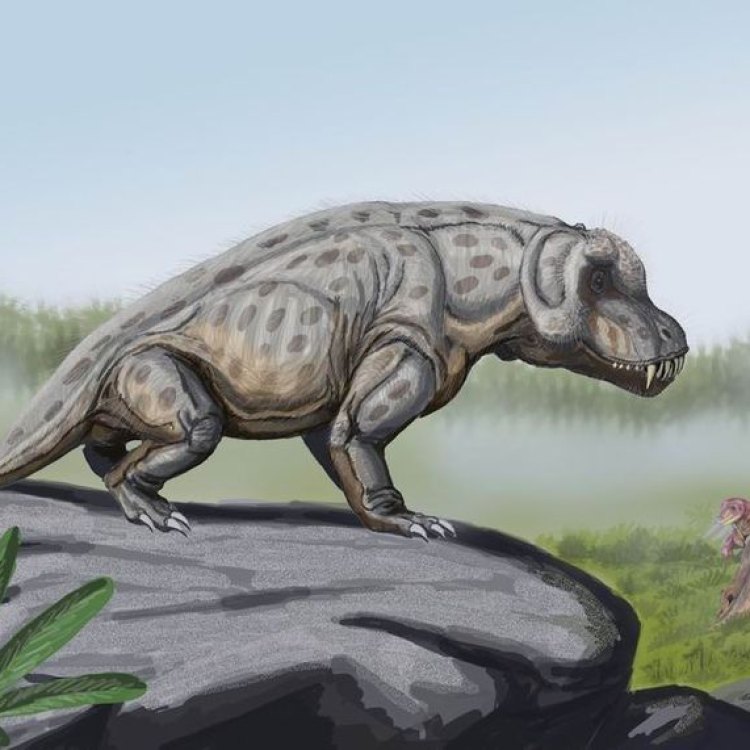
Anteosaurus
- Adult Size: Unknown
- Average Lifespan: Unknown
- Reproduction: Unknown
- Reproductive Behavior: Unknown
- Sound or Call: Unknown
- Migration Pattern: Non-migratory
- Social Groups: Unknown
- Behavior: Unknown
- Threats: Unknown
- Conservation Status: Extinct
- Impact on Ecosystem: Unknown
- Human Use: None
- Distinctive Features: Large size, heavily built body
- Interesting Facts: Anteosaurus is one of the largest carnivorous therapsids known from the fossil record.
- Predator: Unknown
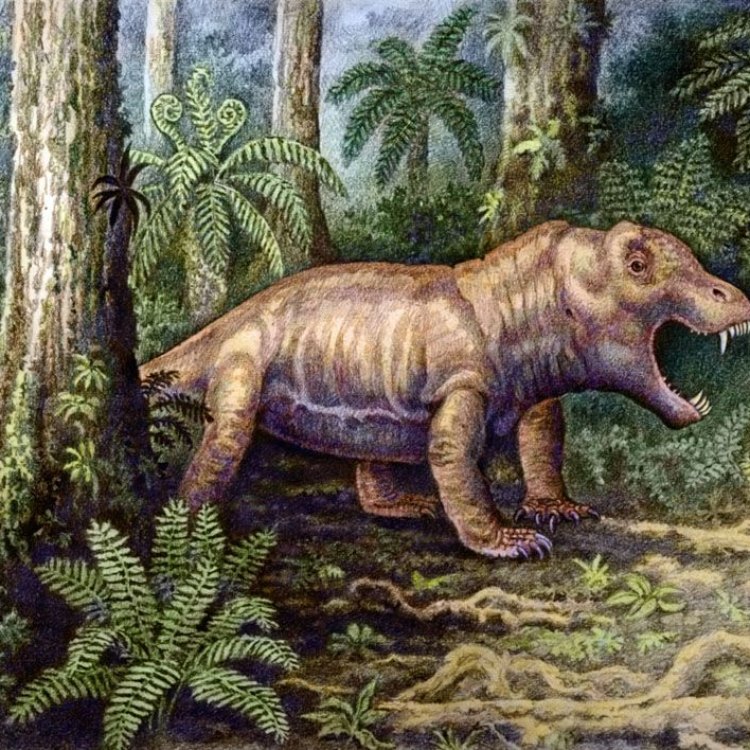
Anteosaurus
Unlocking The Mystery of Anteosaurus: One of the Largest Predators of its Time
Ancient creatures have always fascinated humans. From dinosaurs to giant sharks, we are constantly intrigued by their sheer size and intimidating appearance. And one such creature that has recently come into the limelight is Anteosaurus. This extinct therapsid is not as well-known as its other prehistoric counterparts, but its impressive size and unique features make it a creature worth learning about PeaceOfAnimals.Com.Anteosaurus is a distant relative of mammals, and it existed during the mid to late Permian period, over 250 million years ago. This timeframe makes it one of the oldest known therapsids, also known as “mammal-like reptiles.” However, unlike its smaller relatives, Anteosaurus stood out for its colossal size and predatory nature.
Adult Size: Unknown
One of the most intriguing aspects of Anteosaurus is its unknown adult size. While fossil remains have been found, they only consist of fragments, making it challenging to estimate its exact size. However, based on the fragments found, paleontologists believe that Anteosaurus could have reached a length of up to 4.5 meters (15 feet) and weighed over 450 kilograms (990 pounds). Such size would have made it one of the largest known therapsids, second only to the infamous Gorgonopsid.
Average Lifespan: Unknown
As with its size, the average lifespan of Anteosaurus is also a mystery Axolotl. Fossils do not reveal signs of aging, making it difficult to determine the lifespan of this creature. However, based on its size and predatory nature, it is estimated that Anteosaurus had a relatively long average lifespan compared to other therapsids.
Reproduction: Unknown
Unfortunately, due to the lack of fossil evidence, the reproductive process of Anteosaurus is still a mystery. However, based on the reproductive methods of its distant relatives, it is believed that Anteosaurus was an egg-laying species.
Reproductive Behavior: Unknown
The reproductive behavior of Anteosaurus is another aspect that remains unknown. However, like its other characteristics, it can be hypothesized that Anteosaurus had similar reproductive behavior to other therapsids, including social interaction for mating and nest-building for egg-laying.
Sound or Call: Unknown
It is believed that Anteosaurus had some form of communication, but the exact sound or call it made remains a mystery.
Migration Pattern: Non-migratory
According to paleontologists, Anteosaurus was a non-migratory species and lived in the same location throughout its lifespan. This behavior is commonly observed in apex predators and large mammals, where they establish territories and stick to them.
Social Groups: Unknown
The social behavior of Anteosaurus is also not fully understood. Due to its predatory nature, it is believed that this species lived a solitary life, only coming together during the mating season. However, it is also possible that they may have formed social groups for hunting or protection.
Behavior: Unknown
The behavior of Anteosaurus remains a mystery, but based on its anatomy and predatory nature, it is believed that it was a skilled and fierce hunter. Its powerful limbs and large size make it highly likely that this species was an ambush predator, relying on speed and strength to take down its prey.
Threats: Unknown
Unlike its large and well-known contemporaries such as the T-Rex, there is very little information on the possible threats that Anteosaurus faced. However, it can be assumed that competition from other predators and changes in the environment may have posed a challenge to this species.
Conservation Status: Extinct
Sadly, Anteosaurus is an extinct species with no living relatives. Its fossils have only been found in South Africa and Antarctica, and it is believed that the dominant predators of the time, such as Gorgonopsids, may have been responsible for its extinction.
Impact on the Ecosystem: Unknown
As with most extinct species, the impact that Anteosaurus had on the ecosystem is not fully understood. However, given its size and nature as a top predator, it is believed that its presence would have played a significant role in balancing the ecosystem of its time.
Human Use: None
Unlike other prehistoric creatures, there is no evidence to suggest that Anteosaurus was utilized by humans in any form. Its fossils have only been discovered in remote locations, with no signs of human intervention.
Distinctive Features: Large Size, Heavily Built Body
The most striking feature of Anteosaurus is its impressive size. It was one of the largest carnivorous therapsids of its time, and its heavy build and powerful limbs made it an intimidating predator. Its long, sharp teeth were also crucial for hunting and tearing through its prey's flesh.
Interesting Facts: Anteosaurus is One of the Largest Carnivorous Therapsids Known from the Fossil Record.
While it may not have the same level of notoriety as dinosaurs, Anteosaurus remains a significant and intriguing creature from the past. Its size and predatory nature make it a unique species, and its existence during the Permian period adds to its fascination.
Predator: Unknown
As with other aspects of Anteosaurus, its main predator is still unknown due to the scarcity of its fossil remains. However, it can be assumed that this species faced competition from other predators, such as Gorgonopsids and Inostrancexistia.
In conclusion, Anteosaurus is a prehistoric giant that has left a small but remarkable footprint in history. While its mysteries may never fully be unlocked, its impressive size and unique features make it a creature that continues to captivate our imagination. And as we continue to unearth fossils and gather evidence, we may one day have a better understanding of this magnificent predator and its role in the past ecosystem.
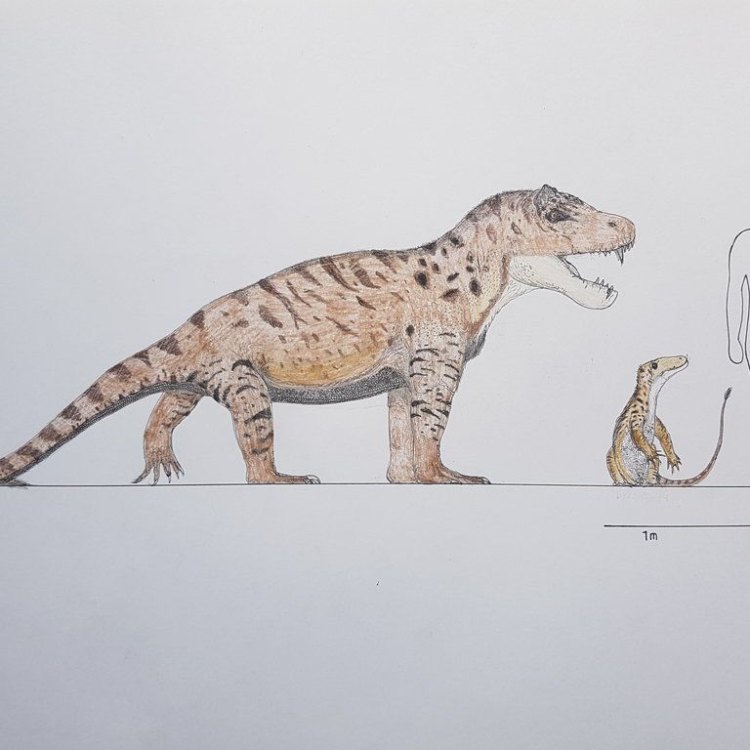
The Mighty Anteosaurus: The Carnivorous Creature of the Karoo Basin
Disclaimer: The content provided is for informational purposes only. We cannot guarantee the accuracy of the information on this page 100%. All information provided here may change without prior notice.


